Are you planning to visit Japan or dine with Japanese friends? Avoid an awkward experience and enjoy your meal by reviewing this essential Japanese table manners guide.
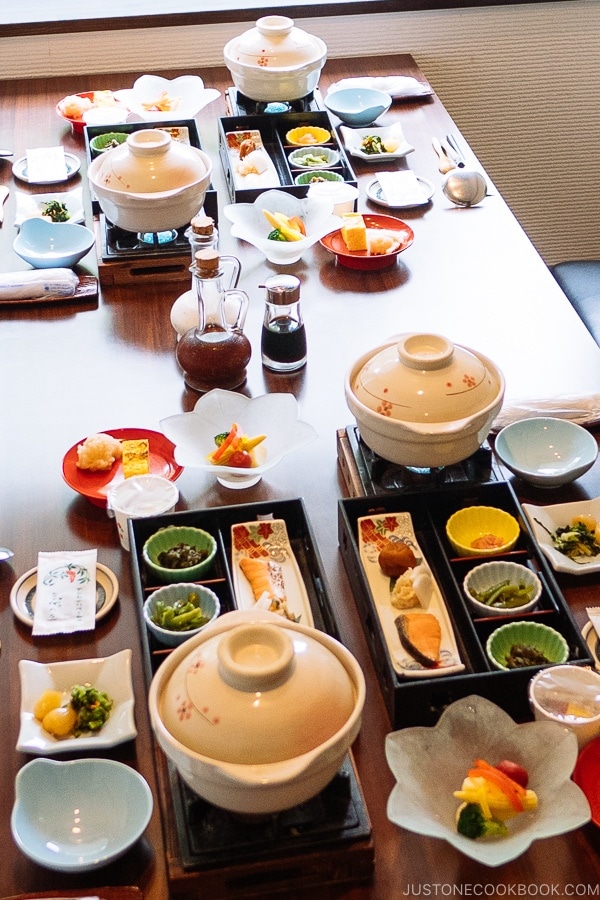
Imagine walking into a Japanese restaurant, perhaps with a few Japanese friends or colleagues. The menu is handed to you, all in Japanese. Your friends hungrily ordered dishes to share, quickly served on steaming hot plates covering the table. You pick up your chopsticks to dig in, and then…?
In mid-action, you notice from the corner of your eye that your new Japanese friends put their hands together, murmur a phrase with a slight bow, and then, with a smile, split their chopsticks apart to partake in the meal.
Oops!???? Have you offended your Japanese friends?!
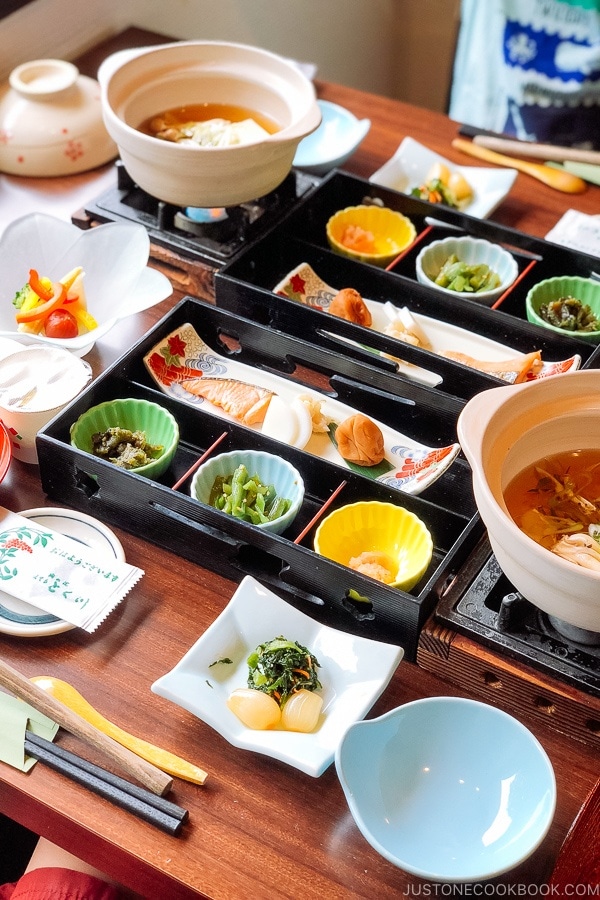
Etiquette rules, especially when dining, are tricky. Eating with others in Japan can be an awkward experience if you’re unaware of the many cultural differences. While you can always play the “I am an outsider to your culture, so please excuse me” card (AKA, the gaijin foreigner card), who doesn’t want to navigate Japanese social norms smoothly without raising eyebrows? After all, who wants to show bad manners to their host or fellow diners?
Let’s get started with an essential guide to Japanese dining etiquette.
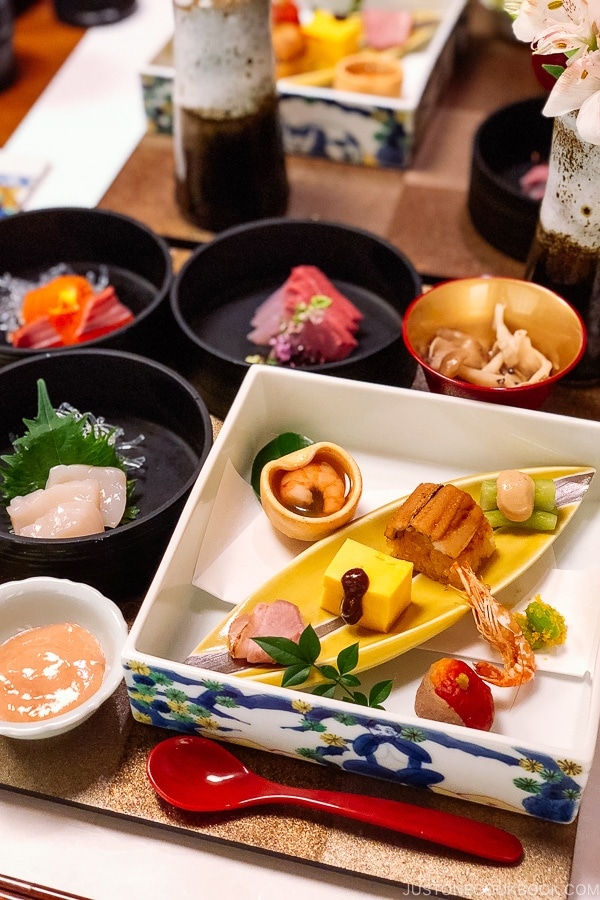
Table of contents
Japanese Dining Etiquette Guide
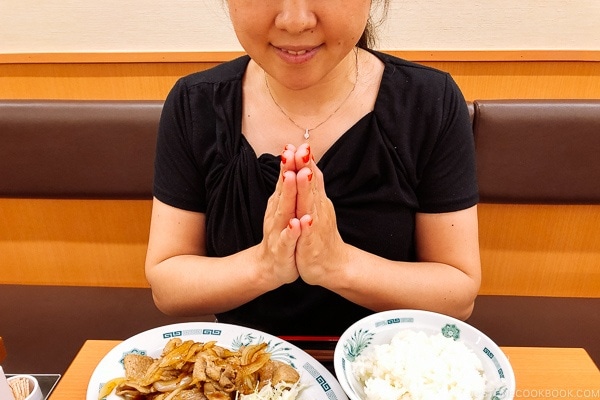
Saying Thanks Before and After Your Meal
So what was that quick but ceremonious greeting before the meal?
You may have noticed the JOC kids saying Itadakimasu いただきます at the end of each JOC video when the meal is ready to eat. Roughly translating to “I humbly partake/receive,” it is similar to saying grace at the beginning of the meal.
When you finish your meal, gently place your chopsticks on the rice bowl or chopsticks rest, and conclude with Gochisou samadeshita ごちそうさまでした, which means ‘thank you for the delicious meal’ or ‘it was quite a meal.’
Let’s practice again: Before you eat, say ‘ Itadakimasu’; at the end of the meal, say ‘Gochisou samadeshita’. Well done!
These greetings during mealtime are deeply rooted in Buddhism and Shintoism, the two main religions of Japan. Saying Itadakimasu and Gochisou samadeshita is the Japanese way of expressing gratitude for nature’s bounty and to the many people who have participated in providing the meal, including the cook, fishermen, farmers, butchers, supermarket employees, truck drivers, and so on.
This ritual in Japan acknowledges the beings (animals and plants) sacrificed and the people who helped create the delicious food before you. Therefore, completing the meal without leftovers or grains of rice in your bowl is even more important than the open and concluding sayings at mealtimes. Finishing the meal shows the utmost respect to the cook and others who have contributed to the meal. If it’s impossible to finish, it is best to shift all the leftover food to the side of your plate or bowl with your chopsticks.
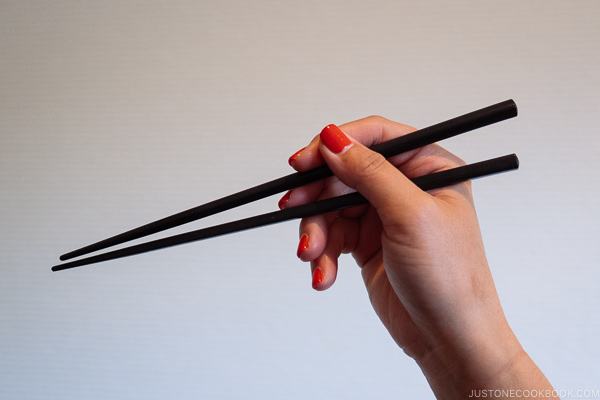
Chopsticks: Do’s/Don’ts
The main utensils in Japan are chopsticks (お箸). While spoons have snuck into modern-day Japanese cuisine, the tradition calls for just chopsticks, which have been used since the 8th century.
There are endless sources that explain how to hold chopsticks properly, so I’ll skip that for this post, but check out this image if you need some brushing up.
Five Don’ts
It’s easier to explain chopstick etiquette with the “don’ts” than the “do’s.” Many don’ts are due to Buddhist funeral rituals or are said to bring bad luck, and thus do not belong at the dining table.
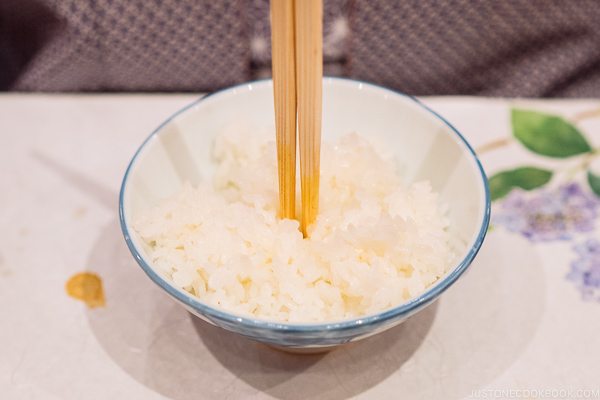
1. Do not stick your chopsticks into food, especially into your bowl of rice (立て箸)
When not using your chopsticks, lay them on the chopsticks rest, or if you’re done with your meal, horizontally on a bowl or plate (never vertically).

2. Do not pass food to another person’s chopsticks with your own (拾い箸)
If you must transfer food to another person, put it directly on his/her plate or bowl.
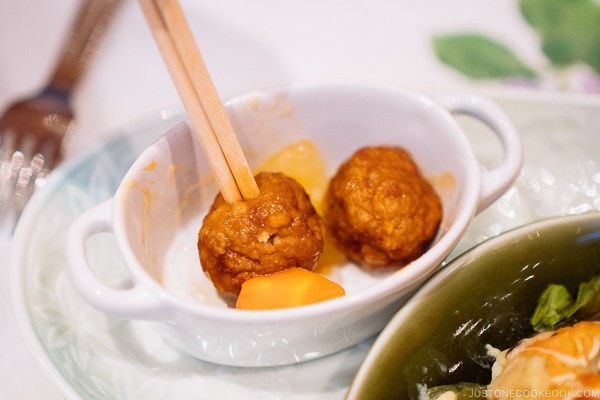
3. Do not spear your food (指し箸)
Chopsticks are meant to be used together like tongs, so pick up the food even if it’s tricky. If you’re concerned that you may drop it, lift the plate or bowl close to your face instead.
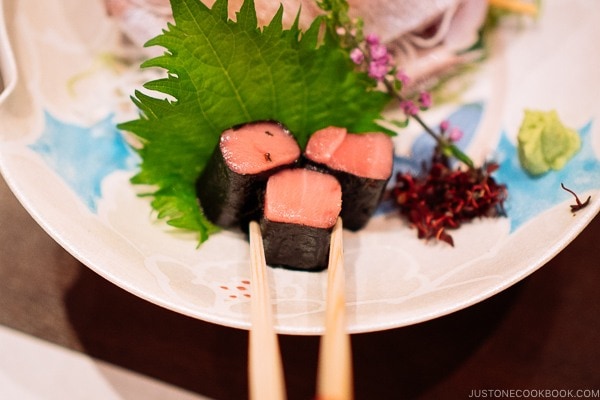
4. Do not use your chopsticks to pick up food from a communal plate
If communal chopsticks are provided, use that instead or flip your chopsticks to use the opposite ends.
However, if you are in a relaxed setting with family or close friends, it may be acceptable to use your chopsticks. When in doubt, watch to see what others do.
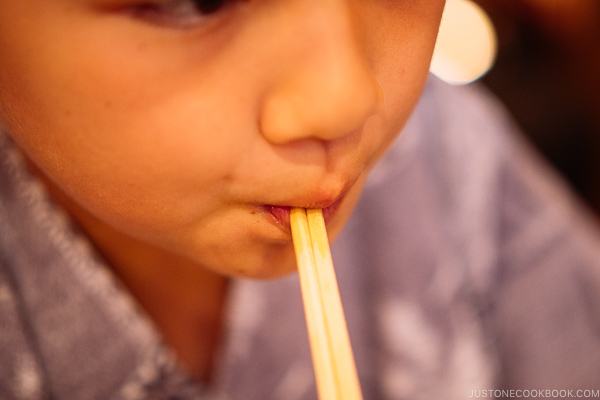
5. Do not lick or chew on your chopsticks (ねぶり箸)
Chopsticks are a tool to transfer food from your plate to your mouth. It may be tempting if bits of food are stuck on your chopsticks, but if you must insist, wipe with a tissue/napkin instead.
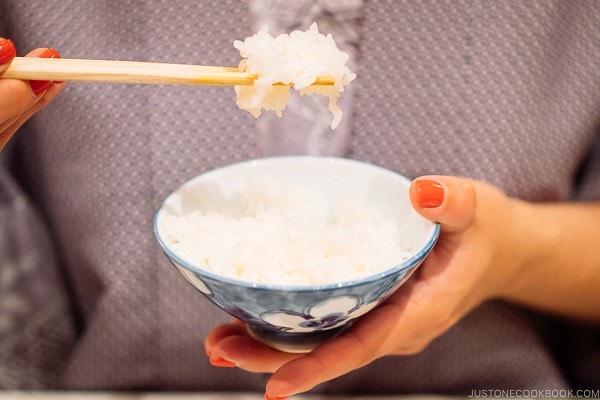
Lifting Plates and Bowls
Your parents or teachers may have taught you not to lift bowls or plates close to your face when eating, but this is acceptable in Japanese culture.
Western table settings utilize tables and chairs, where the chair’s height situates the eater not too far from the plate in front. In contrast, a traditional Japanese meal is eaten on a low table, and seating is close to the ground, hence a farther distance from the table to the face.
Even when Japanese restaurants have adapted to the Western table setting, lifting plates and bowls close to you is still acceptable. This will especially be needed when you’re about to eat something soupy or drippy, which may splatter on your shirt or table (or your neighbor’s!)
Okay to Lift:
- Rice bowls
- Soup bowls, small deep bowls with liquids
- Small plate of soy sauce for sashimi or sushi
- Donburi bowls (with rice or noodles such as ramen or udon) or lacquer rice box (ojyubako))
Do Not Lift:
- Sashimi plates
- Tempura plates
- Communal plates/bowls
- Plates/bowls bigger than the palm of your hand (excluding bowls/plates that have rice, like donburi bowls and lacquer rice box (ojyubako)).
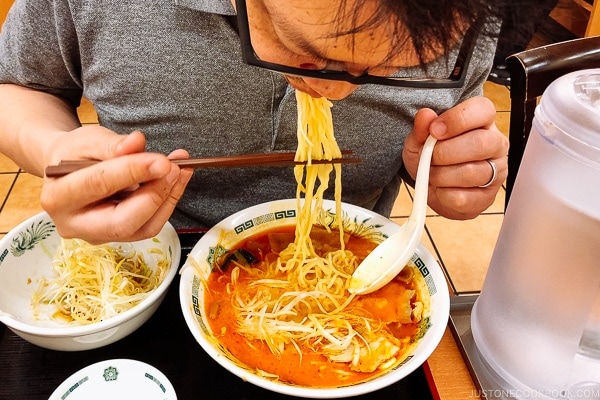
Slurping
Your parents may have taught you not to slurp your noodles. However, it’s perfectly acceptable to slurp away your udon, soba, and ramen when you’re in Japan!
Japanese noodle aficionados will insist that slurping improves the flavor of the noodles, that it helps cool the noodles, or that your nasal passages take in the delicious aromas of the broth. While it’s not mandatory, you may get a nod of appreciation from your Japanese neighbor as you slurp your meal.
Note: the term Nu-hara ヌルハラ (noodle harassment) has been circulating by the Japanese media for a few years due to some Japanese diners irked by the slurping noises. Personally, my advice is: don’t worry about it. Indulge in your meal with noise and gusto!!

Your Experience with Japanese Dining Etiquette
If you unintentionally commit a faux pas when eating in Japan or with Japanese friends, don’t panic! But knowing these Japanese etiquette rules will go a long way, and your friends will respect you for taking the time to understand their culture. And, of course, for being a good guest! Some of you had great questions for this post, and I answered them in Japanese Dining Etiquette Part 2.
Lastly, what Japanese dining etiquette tips have you learned that weren’t mentioned in this post? Or do you have any horrifying stories when dining in Japan? Please share in the comment box below!
Helpful Links
Similar Posts:
- Plan a Japanese Meal: One Soup Three Dishes “Ichiju Sansai”
- Decoding Japanese Food Emojis
- Onsen Etiquette: Your Guide to Japanese Hot Springs


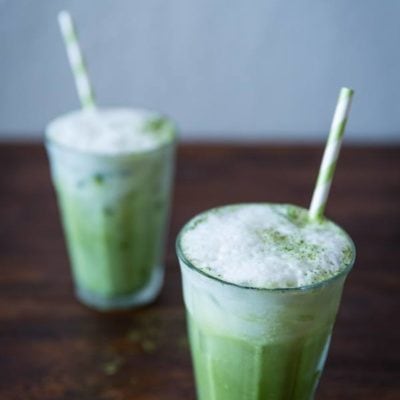

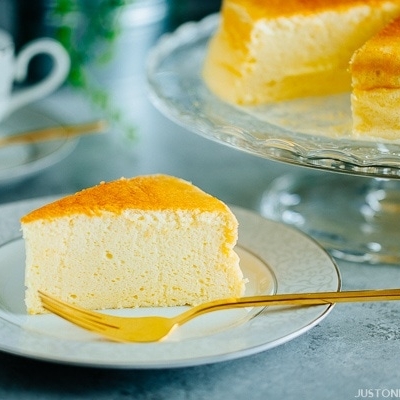


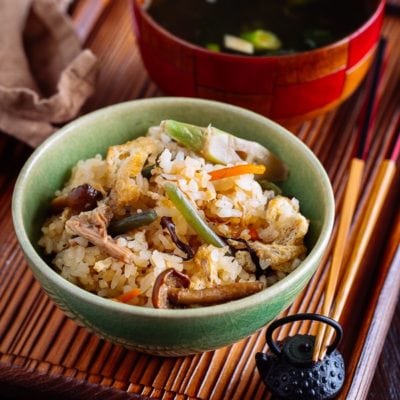
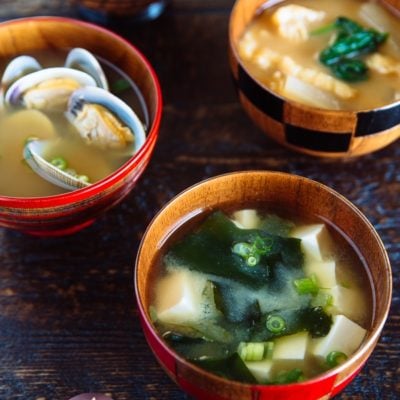


Hello, Kayoko. Thank you for your great advice and answers. After reading your articles, I wonder if we gauche Americans chased my favorite Japanese restaurant, Koji’s, back to Japan! He had two very successful locations in Southern California, and then suddenly packed up and went home!
I did notice one thing, though. It was your statement: “If you were served a fork and/or spoon, place them vertically on the side, like in Western dining, after you finish the meal.” In actuality, although only some, mostly finer, restaurants use this method, it is the tradition to place the used silverware at the top of the dinner plate, in a horizontal position. This then signals the aware server that you are finished, and the plate can be promptly removed. The servers are very observant in many restaurants.
Love your posts!
Hi Jeanne,
Thank you for stopping by and sharing the information with us about traditional silverware placement for signaling the server.
Thank you so much for these tips!! I am planning to go to Japan in a couple years, so definitely want to know ahead of time if there is anything I should and should not do.
I have to say, I kept getting distracted by the table setup, however! Ha ha! I love those little burners and personal donabe!! Are they fairly easy to track down?! Maybe easier in Japan than here in the US?
Hello, Sandie! Thank you so much for taking the time to read Kayoko’s post. We’re glad to hear you enjoyed it.
Yes, it will be easier to find the small Donabe set in Japan, and you will see a wider variety of designs than in the US.
Here’s some Tokyo Kappabashi Kitchenware Town information that you might find helpful.
https://www.justonecookbook.com/tokyo-kappabashi-kitchenware-town/
We hope you have a wonderful trip to Japan!
From my understanding, a little slurping of noodles is a good to include more of the broth with the noodles going into your mouth, which improves the flavor, as you say. I have had to learn to do this, as I was always a nonslurper before. Slurping also does not have to happen loudly. I think a little bit is acceptable in most situations.
Hi Susan, slurping does take some practice to get the right amount of soup without spattering yourself! While we don’t usually make grand gestures in slurping, it’s also true that there are some people, even Japanese people, who are turned off by other people’s slurping noises.
Don’t set your chopsticks down with the tips pointing at anyone dining with you.
Hi Tatsuya! Yes, that’s another good one. In Japan, we always set the chopsticks horizontally, whether before or after eating and never vertically to avoid having the tips pointing at the person in front of you.
Our family lived Tokyo for three years when my husband’s job took him there in 1989, and we have gone back to visit many times since then over the years. Before we moved there, the company paid for us to attend a daylong professional seminar in the U.S. conducted by a Japanese woman and a guy who’d lived there for a long time with useful tips about living there as gaijins, including some of the ones discussed by you and others brought up in the comments. One that stood out that I haven’t seen mentioned was presented as the ultimate no-no while dining: blowing one’s nose! If one was absolutely in need of a tissue, we were told to turn to the side and WIPE, not blow, to solve the drippy problem.
Also, we were advised that one should carry a handkerchief at all times, not for one’s nose but to dry one’s hands in public restrooms. I remember how shocked several friends who visited us in Tokyo were when I just folded the damp hanky nicely and put it back into my purse. Over the years we saw more and more paper towels and air driers in Japan, but actually, the hanky “towel” is more earth-friendly (and fun to collect)!
Finally, the comment about the still-moving ultra-fresh fish resonated with me: we were treated to dinner by Japanese friends at a Yokohama seafood restaurant (tables were reached by walking on wooden pathways winding among indoor water canals!!!) that included a fabulous lobster sashimi course presented on a long wooden boat, with the tail twitching and tentacles still vigorously waving! Our boys still talk about it these many decades later…
Hi Ellen! Thank you for sharing your memorable Japan stories, the cultural differences must have been an eye opener to you and your children! Yes, it’s considered impolite to blow one’s nose in front of others, but it’s not taboo per se, basically another of those unwritten rules that’s difficult to decipher.
Here’s a question- I’m a small woman with a correspondingly small mouth. I read you can’t spear your food. What do I do when I pick up a large (for me) piece of food that I can’t eat in one bite? A big piece of sushi for example.
Thanks!
Hi Chava! Yes, spearing food is considered bad manners. Depending on the sushi, you can take several bites, for example futomaki (although the fillings may fall out). You may be able to take two bites into some types of nigiri sushi but some like squid and octopus may be difficult to cut into two bites.
If you’re at a high-end sushi restaurant, oftentimes the sushi master will make smaller portions to accommodate for smaller mouths, but that’s not always the case.
my cousin had been to japan, and he was looked down upon by people for eating in public while walking! Is it illegal to eat in public while walking?
Hi Cosetta! Thanks for reading. Eating/drinking while walking is not illegal but is generally frowned upon and is seen as bad manners (but you do see some Japanese people snacking while walking, especially in touristy areas). There are several theories why, one is that because the Japanese take eating very seriously and thank their meal before and after eating (as mentioned in the post “itadakimasu” is the ceremonial greeting before a meal) and by eating while walking, you aren’t able to pay your respect to the beings (animals and plants) sacrificed and the various people that helped create the delicious food. Hope this answered your question!
I work for an import/export Japanese company in Los Angeles. When I mentioned to my colleagues slurping, they told me that in a business setting, slurping is not practiced and is considered rude. They told me if you like slurping, then it is best done at home where you are in the privacy of your home.
Hi Andrew, thanks for your reading! Slurping noodles in a business setting is indeed a tricky issue because of the potential offense your fellow colleagues may have. It’s not taboo or bad manners per se, but you definitely need to judge whether it’s appropriate in that certain environment or not. Of course, you can slurp away at the comfort of your home or restaurants.
Thanks for these tips, they are very useful as we are planning to visit Japan again after the pandemic.
Hi Dennis, thank you for your comment! Hope you’ll be able to visit Japan soon 🙂
There is also the matter of how to eat rice. You don’t do what Toshiro Mifune did in “Yojimbo” and sweep it into your mouth.
Hi Chris, thanks for your comment. Yes, we call this sort of eating Inugui (犬食い, literally “eating like a dog”), leaning over your food and shoving it into your mouth and it is not looked well upon.
These are great. Thank you for these fun and informative discussions! ”
I think of itadakimasu more as the “I receive” version and as a phrase of gratitude especially when using things in the temple – to itadaku a gatha book or other implement during the service (Buddhist), we raise it above our head and bow. The “I partake” was new for me. Thank you!
Hello Nanayo, thank you for reading and for your kind words!
My brother is visiting this weekend and I want to show him the best Japanese restaurant since his wife is Japnese. Thanks for mentioning not passing food to someone else using your chopsticks. I’ll be sure to remember these tips so I can enjoy our food and know what to do and what not to do.
Hi Taylor! Hope you had a wonderful meal with your brother and sister in law! Glad this was a timely post!
When In Japan my friend and I met a young couple who asked us out for a meal in a shabu shabu restaurant. My friend chatted with the girl in the couple (her partner wasnt there) for a couple of hours on the train journey to Kyoto and the girl was very keen for us to get together again soon. After a week we did and we had a wonderful meal with lots of laughing and fun as her English was very good though his wasn’t much. We exchanged an email afterwards too. However at the end of the meal when payment time came we didn’t know what to do so we opted for us all to pay for ourselves but was this the wrong thing? I feel we should have paid for them too , although they were very cheerful and seemed to happily agree as we all discussed what to do. Even so, I feel very worried about this even though it was 2 years ago .
Hi Diane! From reading the stories you shared, I wouldn’t worry about this and you can stop worrying about it. In Japan, it’s very common to split the cost so we don’t burden on each other (if I pay then you feel you need to pay next time and you would be worried about making sure to return the favor), so a lot of people split the cost when eating out. We sometimes bring a small gift (Omiyage) to take home etc, but nothing special just a thought. You don’t worry about this event anymore. I think they really had a great time!